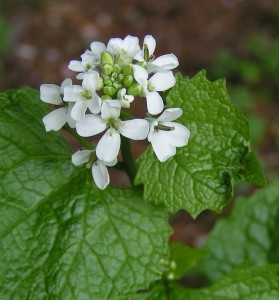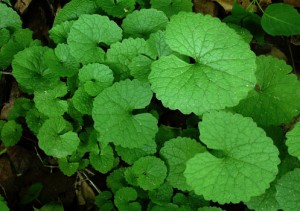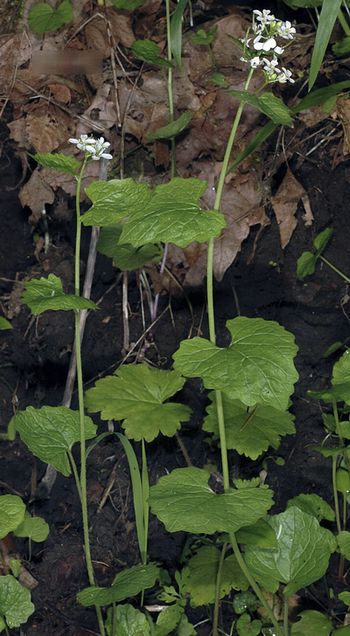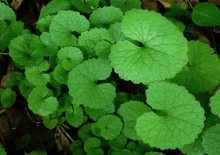— from Kate Yturri, Judy Winer and Gwen Stamm, San Juan Master Gardeners —
 Garlic mustard (Alliaria petiolata) is a flowering herb that was introduced to North America from Europe as a food and medicinal plant. Although edible for humans, it is not eaten by local wildlife or insects.
Garlic mustard (Alliaria petiolata) is a flowering herb that was introduced to North America from Europe as a food and medicinal plant. Although edible for humans, it is not eaten by local wildlife or insects.
It is a fast growing, damaging invasive that once established is difficult to eradicate. It is a biennial or winter annual herb that spreads prolifically by seed. It can cross-pollinate or self-pollinate and quickly out competes native vegetation.
Garlic mustard grows well under many different conditions and has the ability to produce chemicals that inhibit the growth of other plants and mychorrizal fungi needed for healthy tree seedling survival and tree growth. Garlic mustard is a Class A noxious weed with a limited distribution in Washington, and eradication is required state-wide. It is also on the Washington quarantine or prohibited plants list and is prohibited to transport, buy, sell, offer for sale, or to distribute. It has been found overtaking a private garden near Eastsound on Orcas.
 First year garlic mustard is a low growing rosette with rounded kidney shaped, scalloped edged leaves.
First year garlic mustard is a low growing rosette with rounded kidney shaped, scalloped edged leaves.
Garlic mustard looks similar in appearance to the non-native and common nipplewort, (Lapsana communis), however garlic mustard leaves are not fuzzy or hairy like nipplewort. Second year plants typically grow to 3 feet tall, but can be a few inches to over 6 feet tall. The upper leaves on each stem become more triangular and smaller toward the top of the plant. They are coarsely toothed, and often smell like garlic when crushed. The flowers are small and white with 4 petals and appear in early spring in clusters at the top of the stem. Plants are usually single stemmed but if crushed or cut they will develop multiple stems. Roots typically have a characteristic S-shaped bend.
 First year rosettes are usually noted in mid summer through the following spring and then the plant bolts into the upright mature stage in late April though May. Seed production rapidly follows. Since garlic mustard can tolerate a wide range of light, soil, moisture and terrain conditions it can be found anywhere. Seeds are small and easily spread by animals, people, and vehicles and also by water, birds and other vectors. Seeds can last in the soil for up to 10 years.
First year rosettes are usually noted in mid summer through the following spring and then the plant bolts into the upright mature stage in late April though May. Seed production rapidly follows. Since garlic mustard can tolerate a wide range of light, soil, moisture and terrain conditions it can be found anywhere. Seeds are small and easily spread by animals, people, and vehicles and also by water, birds and other vectors. Seeds can last in the soil for up to 10 years.
Control is very difficult so identification is most important so that the plants can be removed before established and infestations can be prevented. Hand pulling plants is effective if the entire root is removed. If plants are flowering or seeding, they must be bagged and discarded in the garbage. Care must be taken to clean clothing, shoes and tools to avoid carrying the seeds to new sites. After pulling, it may help to cover dense infestations of garlic mustard with wood chip mulch to reduce germination of seeds left behind. Infested sites should then be monitored closely for new plants.
If you suspect you have found garlic mustard please call the SJC Noxious Weed Board at 376-3499. Photos are from King County Noxious Weed Board and Ben Legler.
**If you are reading theOrcasonian for free, thank your fellow islanders. If you would like to support theOrcasonian CLICK HERE to set your modestly-priced, voluntary subscription. Otherwise, no worries; we’re happy to share with you.**








